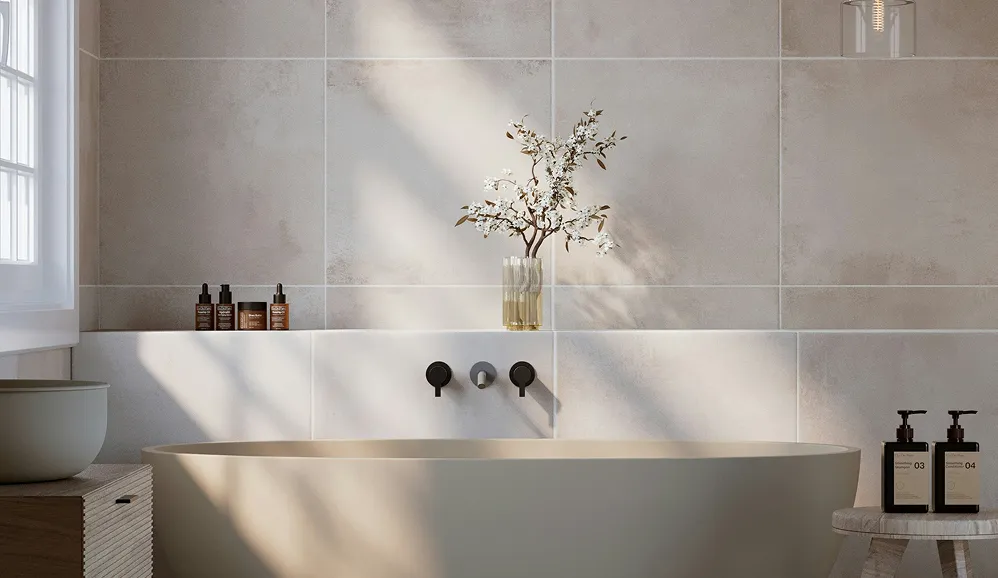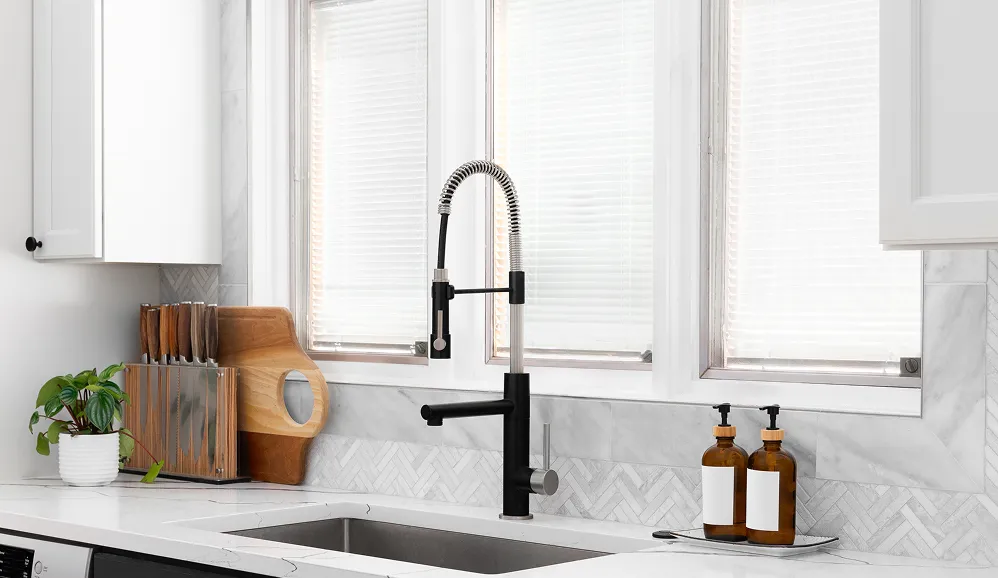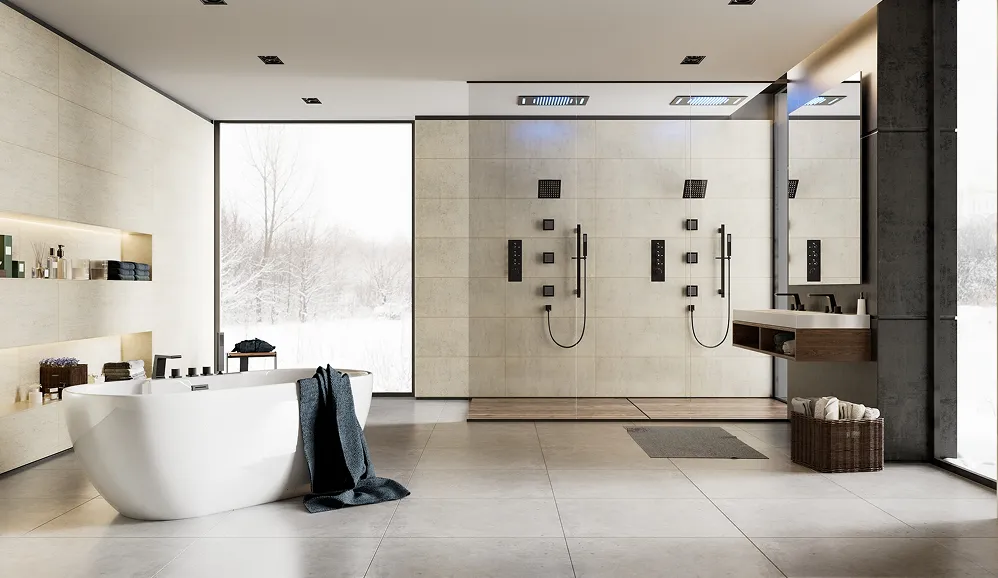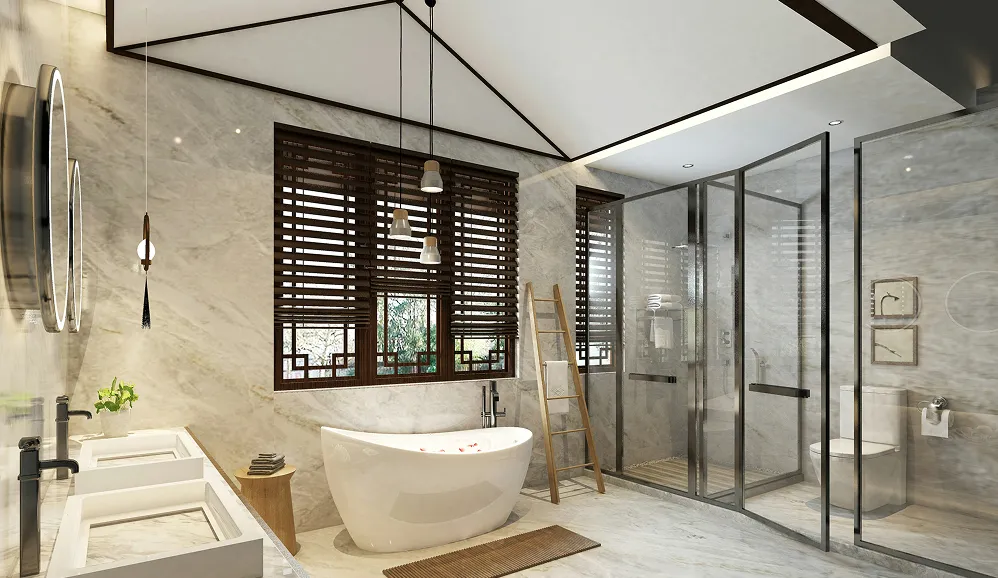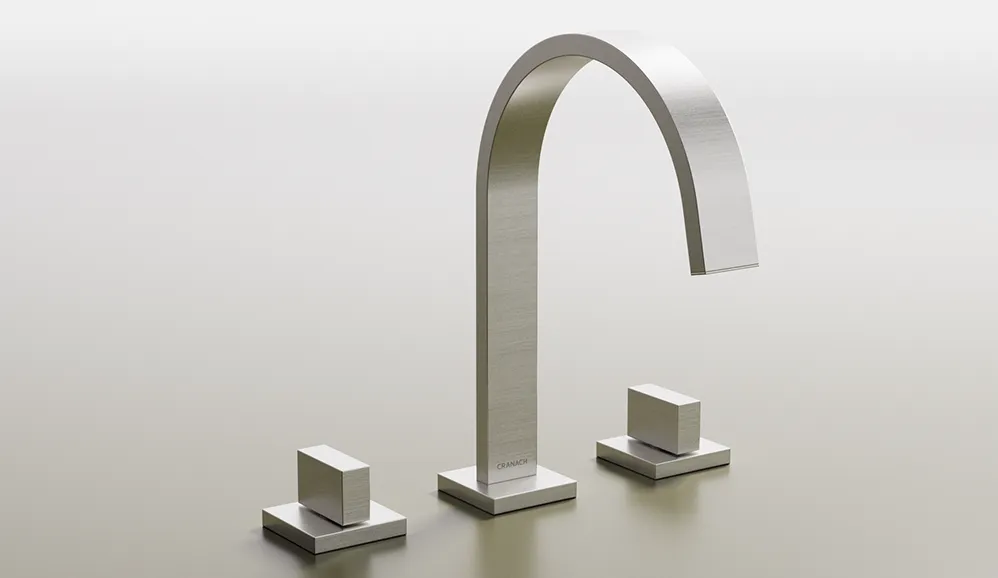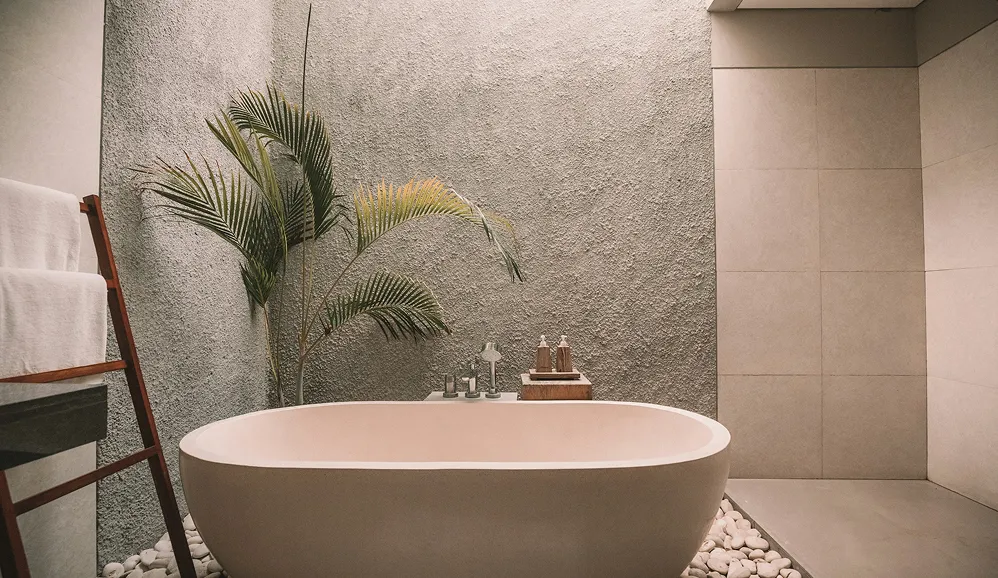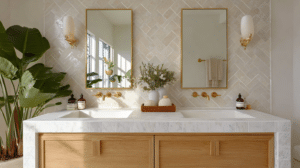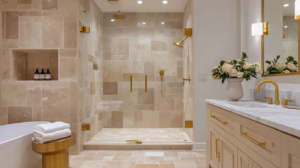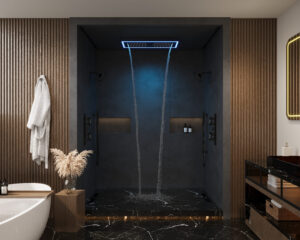Trying to nail down the cost of a shower remodel can feel a bit like asking, “How much does a car cost?” The answer really depends on what you’re looking for. A basic refresh might only set you back $1,500 to $4,000, while a more thorough mid-range project usually lands in the $5,000 to $10,000 ballpark. If you’re dreaming of a full-blown luxury spa, costs can easily climb past $12,000.
Your Quick Guide to Shower Remodel Costs
The first step in planning your shower remodel is getting a handle on the different budget tiers. Your final bill is a mix of three things: the scope of the work, the materials you choose, and how complex the installation is. Thinking about your project as either budget-friendly, mid-range, or luxury from the get-go helps set a realistic roadmap.
For example, a budget-friendly job might stick to surface-level changes—think new fixtures, fresh grout, or a simple pre-made shower stall. A mid-range remodel, on the other hand, often involves bigger moves, like converting an old tub into a modern walk-in shower or installing custom tile. For anyone considering that popular upgrade, it’s worth digging into the specific costs tied to a walk-in shower.
Shower Remodel Cost at a Glance by Project Tier
To give you a clearer picture, it helps to see what you actually get for your money at each level. It’s no surprise that costs can swing wildly based on how big you go. A simple refresh is one thing, but a high-end remodel with premium stone, rerouted plumbing, and spa jets can push the budget to $25,000 or more. You can dive deeper into a full cost analysis in this excellent guide from Forbes.
This table breaks it down simply, helping you match your vision to a practical budget.
| Project Tier | Estimated Cost Range | Common Scope and Materials |
|---|---|---|
| Budget | $1,500 – $4,000 | New fixtures, re-grouting, prefab shower insert, new shower door. |
| Mid-Range | $5,000 – $10,000 | Walk-in shower conversion, quality ceramic or porcelain tile, semi-custom glass. |
| Luxury | $12,000+ | Natural stone, custom tile work, frameless glass, moving plumbing, adding body jets. |
Getting familiar with these tiers gives you a solid foundation for planning. It helps you decide where to spend and where to save to get that perfect blend of function, style, and value for your new shower.
What Drives the Cost of a Shower Remodel?
Ever get a quote for a shower remodel and wonder why the numbers vary so wildly? You might see one for $3,000 and another that soars past $15,000. The truth is, there’s no single answer to how much to remodel a shower. The final price tag really comes down to three key things: the materials you pick, the labor needed to put it all together, and the overall scope of your project.
Think of it like building a custom car. You can start with a basic frame, or you can go for a top-of-the-line chassis. Each choice, from the engine to the paint job, adds to the final cost. Your shower is no different.
This image gives you a quick snapshot of where your money typically goes.
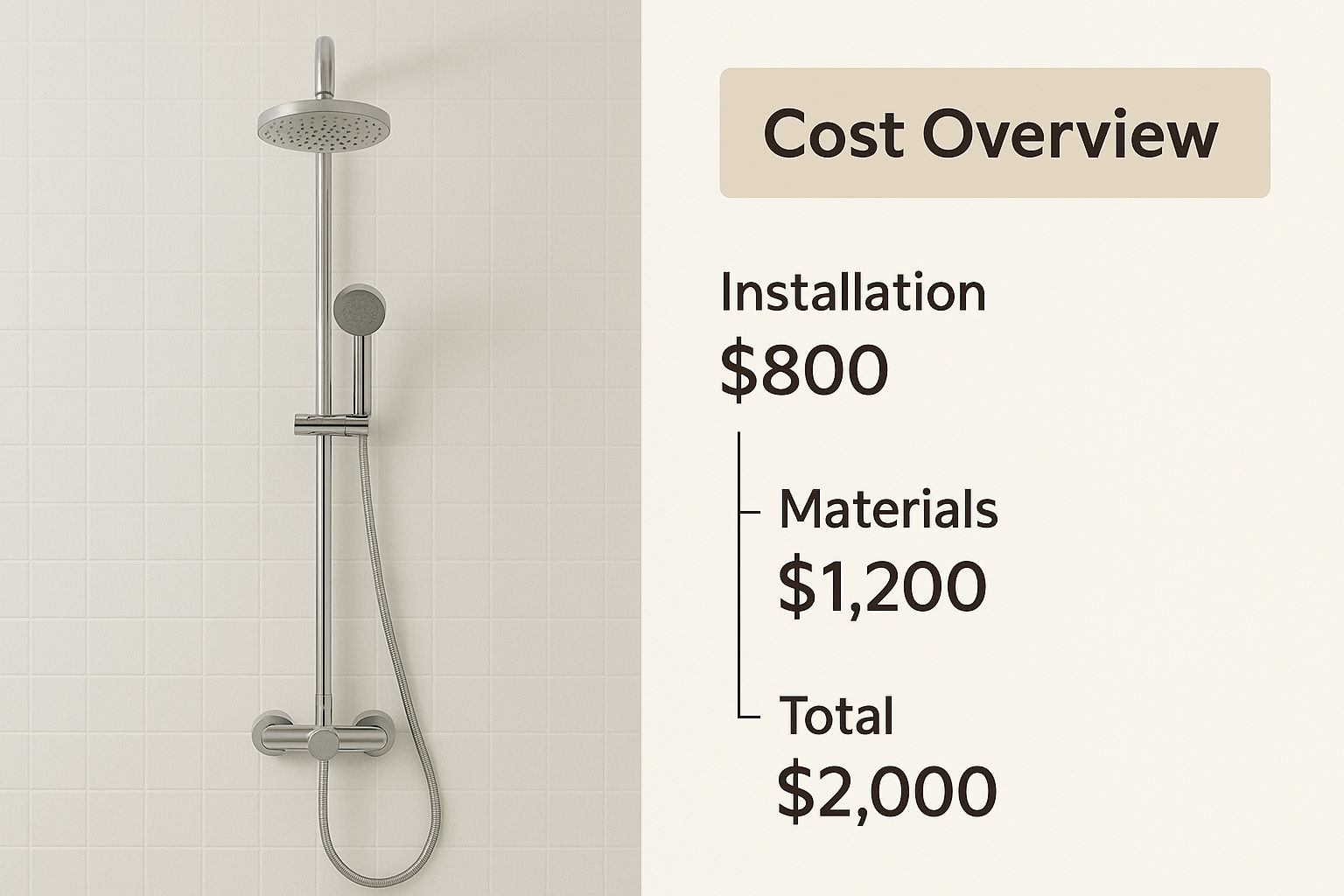
As you can see, materials and labor aren’t just small pieces of the pie—they are the pie. The scope of your project just determines how big that pie is going to be.
The Big Two: Materials and Labor
Your choice of materials is the first major fork in the road for your budget. You could go with a wallet-friendly, pre-fabricated fiberglass unit or splurge on high-end natural stone that feels like a luxury spa. Then comes labor, which is the other half of this powerful duo. The cost for skilled hands can swing dramatically depending on where you live.
These two elements are completely intertwined and will always command the lion’s share of your budget.
According to the National Kitchen & Bath Association (NKBA), labor alone can eat up 20% to 40% of a bathroom project’s total cost. And when it comes to materials, the range is huge. A basic prefabricated shower stall might cost just $500, while custom tile work can easily run you $3,500 or more for the materials and installation combined.
It’s tempting to hire individual tradespeople to save a few bucks, but a general contractor orchestrates the whole project. That management can be worth the extra cost, often preventing expensive errors and delays down the line.
How Project Scope Shapes Your Final Bill
Of all the factors, the scope of your project is the single most powerful one. It’s simple, really: a bigger, more ambitious vision requires more materials and more hours from skilled professionals. This is where costs can really climb.
Here’s a look at how different project scopes stack up:
- Simple Fixture Swap: This is your most budget-friendly option. You’re just giving your shower a facelift by replacing the shower head, handles, and valve trim. The plumbing and tile stay put, making it a quick cosmetic refresh.
- Full Gut Renovation: Now we’re talking serious business. This means tearing everything out right down to the wall studs. You’ll be installing new waterproofing, tile, fixtures, and likely a new shower pan. This is the standard for most mid-range and luxury remodels.
- Tub-to-Shower Conversion: This has become an incredibly popular project. You’re taking out an old, bulky tub to create a sleek, accessible walk-in shower. It’s a major undertaking that involves a lot of plumbing, tile work, and waterproofing.
- Expanding the Footprint: This is the most expensive route, period. If you want a bigger shower, you’re talking about moving walls. That means reframing, serious plumbing and electrical rerouting, and all new drywall—on top of everything a gut renovation requires.
Anytime you have to move plumbing lines, you’re adding a significant layer of complexity and cost. Since plumbing is such a core part of the job, getting familiar with how professionals price plumbing jobs can give you a much clearer picture of what to expect and help you manage that part of your budget.
Choosing Your Ideal Shower System and Features
Let’s talk about the heart of your new shower: the hardware. Beyond the tile and the layout, the fixtures you choose will define your daily experience, turning a simple rinse into a genuine moment of relaxation.
Your decision on a shower system is a huge factor in the final answer to how much to remodel a shower. These components can range from the most basic setups to something that feels like your own private spa.
A high-quality, integrated shower system, like those we offer at CRANACH, isn’t just a shower head; it’s an engineered experience. These systems are designed to bundle everything you need—a rainfall head, a handheld wand, and maybe even body jets—all controlled by a single, intuitive valve. This approach not only gives you a clean, cohesive look but guarantees all the parts work together perfectly.
Selecting The Right Valve And Shower Head
The valve is the unsung hero of your shower. It’s the component hidden behind the wall that controls both your water temperature and pressure. Getting this part right is absolutely key to a satisfying remodel.
- Pressure-Balancing Valves: Think of these as the reliable standard. They’re affordable and get the job done by balancing the pressure of hot and cold water. This is what prevents that dreaded scalding surprise when someone flushes a toilet elsewhere in the house.
- Thermostatic Valves: This is a serious upgrade. A thermostatic valve lets you pre-set your perfect temperature. It then works automatically to mix the hot and cold water to hold that exact temperature, no matter what. It’s a touch of luxury that delivers a much more precise and comfortable shower.
Even a quick look at industrial water flow control valve systems shows you just how much engineering goes into managing fluids. For your home, these advanced valves are what give you that consistent comfort and safety, day in and day out.
Popular Features And Finishes
Once you’ve sorted out the valve, it’s time for the fun part—the elements you see and interact with every day. Dual shower heads, which typically combine a fixed rainfall head with a flexible handheld wand, offer incredible versatility. When it comes to finishes, matte black and brushed nickel are still top contenders for their modern look and knack for resisting fingerprints.
One of the most common regrets I hear from homeowners is that they focused only on looks and forgot about function. A huge rainfall shower head looks stunning, but it can be a pain if you don’t want to wash your hair every single day. A dual-head system really does give you the best of both worlds.
A fantastic shower also needs one more thing: great water pressure. If you’re investing in a beautiful multi-function shower system, you need to be sure your home’s plumbing can keep up. We have a whole guide on how to increase water pressure in a shower if you want to learn more. By thinking through each of these components, you’re not just building a beautiful shower; you’re creating one that’s perfectly suited to your life.
DIY vs. Pro: What’s Right for Your Remodel?
One of the biggest crossroads you’ll face when planning your remodel is deciding whether to roll up your sleeves and do it yourself or bring in a professional. This choice goes way beyond just comparing labor costs against your budget. It’s a genuine, honest-to-goodness calculation of your skill level, the time you can spare, the risks you’re willing to take, and the quality you expect at the finish line.
Going the DIY route looks like a huge money-saver on paper, and it can be. But it also comes with its own “hidden” expenses that catch a lot of homeowners by surprise.
When you choose to DIY, you’re not just the homeowner anymore. You’re the project manager, the plumber, the tiler, and the clean-up crew. For someone with the right skills, that can be incredibly empowering. But it also means you’re on the hook for every tool rental, every trip to the hardware store, and most importantly, every single mistake. A poorly installed waterproof membrane, for example, isn’t just a small oops—it’s a catastrophic error that can lead to thousands in water damage repairs down the line, completely erasing any money you thought you saved.
Let’s be real: some tasks just aren’t meant for amateurs. Complex plumbing adjustments, adding new electrical for mood lighting, and getting that perfect, watertight seal are jobs that really need the precision—and licensing—of a pro. Imagine forgetting to install an access panel for your new shower system‘s plumbing. What could have been a simple future fix suddenly becomes a tile-smashing, wall-opening nightmare.
The True Cost of DIY
The appeal of slashing labor costs is powerful, I get it. But you have to weigh those savings against the real value of your own time and the potential for some seriously expensive mistakes. Before you grab that sledgehammer, take a hard look at these points:
- Tool and Equipment Costs: Do you actually own a tile saw, a high-quality level, and all the right trowels? Renting or buying the specialized tools for the job can easily add hundreds of dollars to your budget.
- The Learning Curve: Watching a 10-minute video is one thing. Properly mixing thin-set mortar to the perfect consistency or cutting intricate tile patterns around a niche is a whole different ball game. Mistakes mean wasted materials, which means buying more and watching your costs climb.
- Inspections and Permits: A seasoned pro knows the local building codes like the back of their hand and will handle the entire permitting process. A DIY job that isn’t up to code might have to be torn out, and it could cause major headaches when you eventually decide to sell your home.
A classic DIY mistake is just patching over a problem without understanding what caused it. You might see a small drip and think it’s just a worn-out washer. But if you try a quick fix without knowing the root cause, you could be setting yourself up for a much bigger headache. It’s smart to first learn how to properly fix a leaky shower faucet to see if it’s a symptom of a larger issue you need to address.
When to Hire a Pro
So, what are you really paying for when you hire a professional contractor? It’s more than just their labor. You’re buying peace of mind, access to their trade discounts on materials, and accountability. You’re paying for their expertise, their efficiency, and the insurance that protects you from costly errors.
A pro can knock out a project in a fraction of the time it would take a novice, which means less disruption to your daily life. They handle the whole orchestra—coordinating the plumber, the electrician, the tiler, and the glass installer—to make sure the project flows smoothly and is done right the first time.
Ultimately, the choice between DIY and hiring a professional is a personal one. It comes down to an honest assessment of your skills, your budget, and your tolerance for risk. To help you decide, here’s a quick breakdown of what each path looks like.
DIY vs. Professional Shower Remodel Comparison
Deciding between a DIY remodel and hiring a professional is a crucial step. This table breaks down the key factors to help you weigh the pros and cons of each approach for your specific situation.
| Factor | DIY Approach | Hiring a Professional |
|---|---|---|
| Cost | Lower upfront labor cost, but potential for higher material costs due to mistakes and tool rentals. | Higher upfront cost due to labor, but often includes material discounts and a fixed budget. |
| Timeline | Typically much longer; dependent on your free time, learning curve, and unforeseen challenges. | Significantly faster and more predictable; professionals work efficiently and on a set schedule. |
| Skill & Quality | Quality depends entirely on your skill and experience. High risk of amateur-looking results or critical errors. | Guaranteed professional-quality finish. Work is often warrantied and insured against errors. |
| Tools & Equipment | You are responsible for buying or renting all necessary specialized tools, which can be costly. | The contractor provides all necessary professional-grade tools and equipment. |
| Stress & Management | High stress. You manage all scheduling, purchasing, problem-solving, and physical labor. | Low stress. The contractor manages the entire project, from permits to subcontractors and cleanup. |
| Risk | You assume all risk for mistakes, potential water damage, and repairs if the job fails code inspection. | The contractor is licensed and insured, assuming liability for workmanship and potential damages. |
After looking at the comparison, think about what matters most to you. Is it saving money at all costs, even if it means more stress and a longer project? Or is the peace of mind and guaranteed quality of a professional finish worth the investment? There’s no single right answer, only the one that’s right for you and your home.
Budgeting Smarter to Avoid Surprise Costs
A solid, detailed budget is the absolute bedrock of any successful remodel. It’s what turns your vision from a daydream into a real, achievable plan. The real secret to figuring out how much to remodel a shower without blowing your budget is to anticipate all the little costs, not just the big-ticket items like tile and fixtures. Think of a smart budget as your financial blueprint—it guides every single decision you make.
The best way to start is by creating a line-item budget. And I don’t mean just a list of the major stuff. I’m talking about a granular breakdown of every single component, from the tile and grout all the way down to the screws, sealant, and paint. For a wider lens on planning and managing your expenses, it’s worth reading up on general remodeling considerations, which can really help you think through all the details.
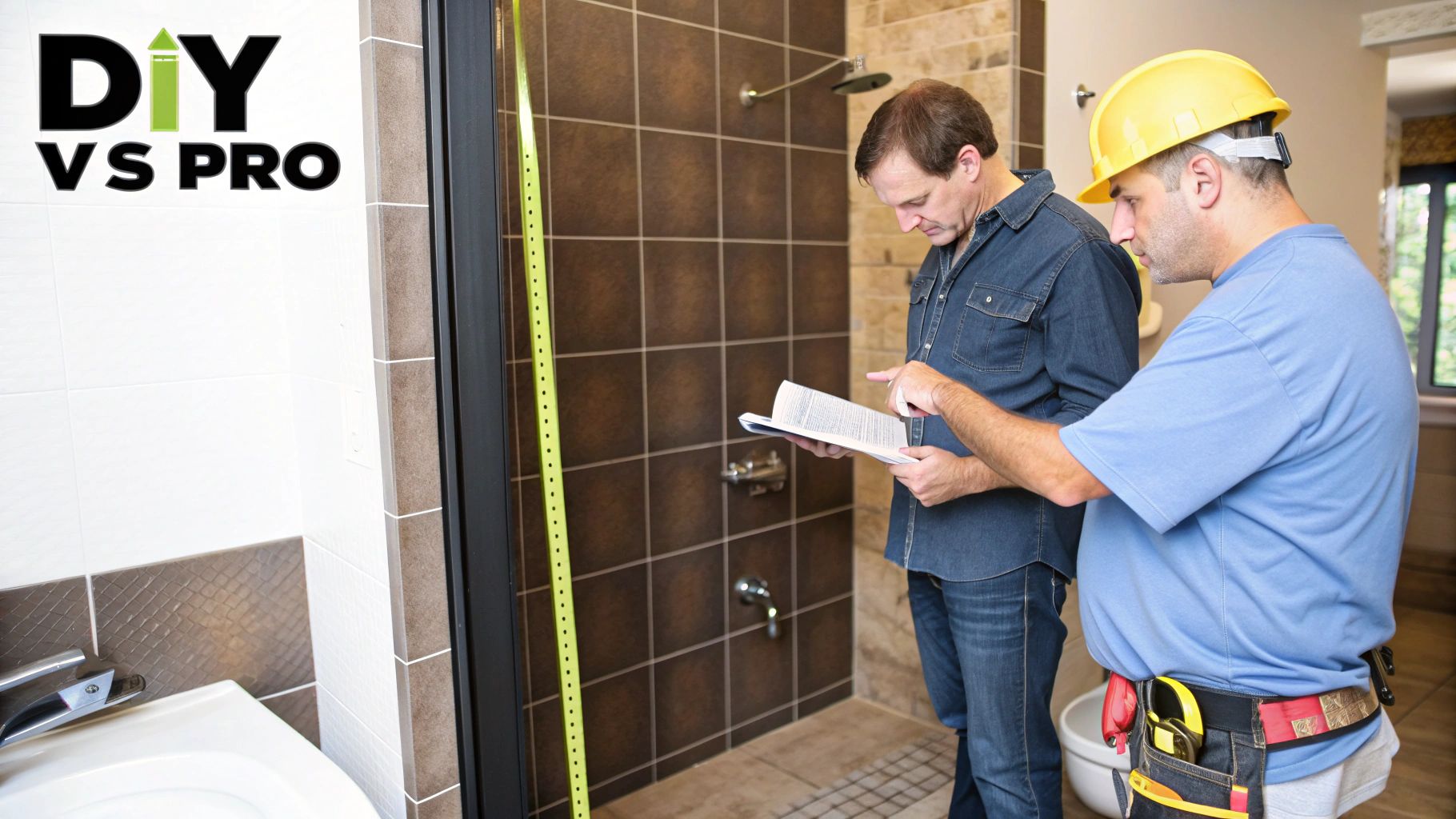
The Essential Contingency Fund
Here’s a hard-earned piece of wisdom: no matter how perfectly you plan, remodels are notorious for revealing surprises once you open up the walls. This is where a contingency fund—a buffer of 15% to 20% of your total budget—becomes your most valuable asset.
This isn’t “extra” money; it’s a calculated safety net. It’s the fund that covers the curveballs, like discovering hidden water damage behind old tile, needing to upgrade ancient plumbing to meet current building codes, or finding structural issues that have to be fixed before you can move forward.
Without that buffer, one small, unexpected problem can completely derail your project. You might be forced to make tough compromises on the quality or features you were really excited about.
Savvy Tips for Saving Without Sacrifice
A tight budget doesn’t mean you have to settle for a result you don’t love. With a bit of strategic planning, you can bring your costs down significantly while still getting that high-end look and feel you’re after. According to the U.S. Census Bureau’s Survey of Construction, homeowners are consistently investing in bathroom upgrades, especially in larger, curbless showers. These accessibility features are fantastic but can add 20-30% to the project cost, making smart savings even more critical.
Here are a few proven ways to stretch your dollars further:
- Source Materials During Sales: Keep an eye out for seasonal sales at the big-box stores and your local suppliers. Buying tile, fixtures, or even a new CRANACH shower system during a promotion can save you a surprising amount of money.
- Choose Lookalike Materials: Natural stone is gorgeous, but it comes with a hefty price tag. High-quality porcelain tiles that mimic the look of marble or slate can give you a nearly identical aesthetic for a fraction of the price, and they’re often more durable and easier to maintain.
- Get Multiple Itemized Quotes: This is non-negotiable. Always get at least three detailed bids from different contractors. An itemized quote breaks down the costs for labor and materials, so you can truly compare apples to apples and make sure you’re getting a fair price for the work.
And don’t forget, a bigger shower or an upgraded shower system will also affect how much water you use. It’s a smart idea to factor that into your long-term planning. To get a better handle on it, check out our guide on how many gallons of water a shower uses.
Got Questions About Your Shower Remodel? We’ve Got Answers.
As you get closer to kicking off your project, it’s completely normal for a list of questions to start piling up. Getting solid answers is the best way to feel confident about figuring out how much to remodel a shower and what the job really involves.
Think of this as your go-to guide for the most common worries homeowners have. We’ll get straight to the point on timing, what work is actually necessary, and how to deal with contractors without getting overwhelmed.
How Long Does a Typical Shower Remodel Take?
The timeline for a shower remodel can swing pretty wildly depending on how complex it is. A simple, straightforward job—like just swapping out old fixtures and replacing a basic tile surround—might only take 3-5 days of actual work.
But a full gut renovation is a whole other ballgame. If you’re moving plumbing, putting in a custom tile design, and adding a frameless glass door, you need to be prepared for a longer project. These bigger jobs can easily stretch from 2 to 4 weeks, from the first swing of the hammer to the final wipe-down. And that doesn’t even factor in the time it takes to plan everything and wait for materials to show up.
Can I Just Replace the Tile Without a Full Redo?
Technically, you can just replace the tile, but almost any pro worth their salt will tell you it’s a bad idea. The real issue is what’s hiding behind that tile: the waterproof membrane. This layer is the single most important thing protecting your walls from water.
Tiling over old tile or just chipping off the surface leaves the original, aging membrane right where it is. That’s a huge gamble. If that old barrier is compromised in any way, you’re setting yourself up for hidden leaks, rot, and the kind of expensive water damage that ruins budgets and weekends.
A full tear-out down to the studs is the only way to be certain you have a brand-new, perfectly installed waterproofing system. It’s the approach that gives you real peace of mind and protects your investment for years to come.
What’s the Best Way to Get Accurate Contractor Quotes?
Getting quotes you can actually compare side-by-side is absolutely critical to keeping your budget in check. The secret? Make sure every single contractor is bidding on the exact same project.
Give each contractor a detailed document outlining the scope of your project. It should include:
- Material Specs: Get specific. List the exact tile, fixtures, and the shower system you’ve picked out.
- A Simple Sketch: You don’t need to be an architect. A basic drawing showing the layout, dimensions, and where you want features like a niche or a bench is incredibly helpful.
- A List of Features: Clearly write down any special add-ons, like heated floors, custom lighting, or a curbless entry.
Always, always ask for an itemized quote that separates labor and material costs. And don’t forget the due diligence: verify their license and insurance, and ask for at least three recent references you can actually call. Keeping your new fixtures in top shape is also part of the plan; you can learn more in our guide on how to clean a shower head. This proactive approach is your best defense against hiring the wrong person and ensures you get a fair price.
Ready to elevate your daily routine with a touch of therapeutic luxury? A CRANACH shower system is the perfect centerpiece for your new bathroom, blending stunning design with unparalleled performance.
Explore our complete collection of advanced shower systems today!

